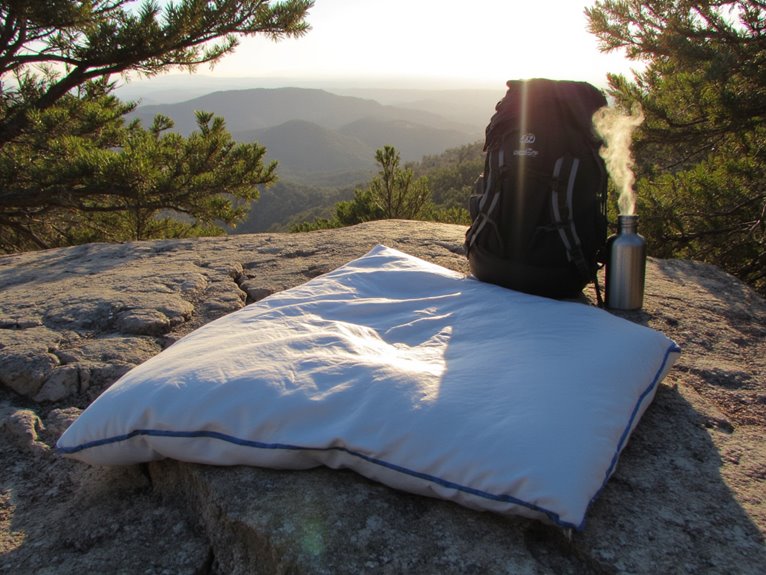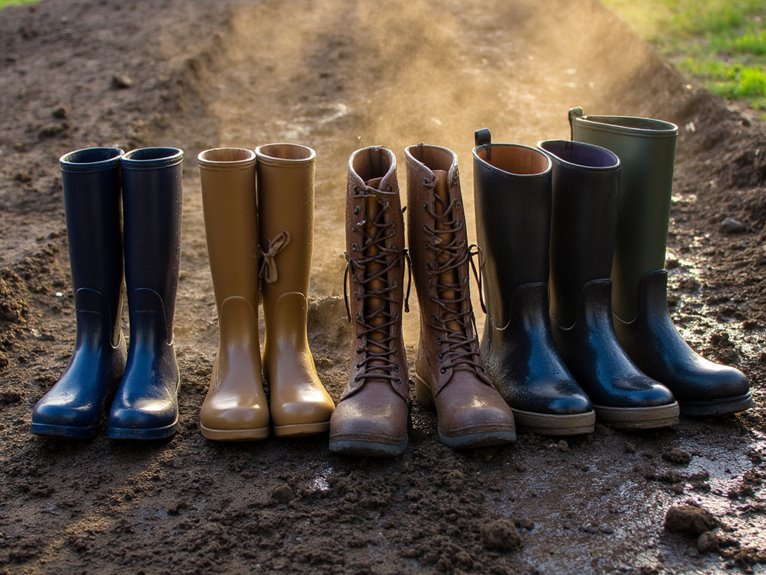Trail Etiquette on Crowded Hiking Trails: Passing and Camping
On crowded trails, you’ll follow established right-of-way rules: horses have priority, then hikers, then bikers, with uphill travelers taking precedence over descending users. When camping, select sites 200+ feet from water sources and bury waste 6-8 inches deep at the same distance. Social media’s viral content can increase daily visitors to 600, overwhelming trail infrastructure. You’ll need proper safety gear including GPS devices, since 17% of trail deaths result from falls. Understanding group dynamics and timing strategies reveals additional techniques for minimizing your environmental impact.
We are supported by our audience. When you purchase through links on our site, we may earn an affiliate commission, at no extra cost for you. Learn more. Last update on 7th January 2026 / Images from Amazon Product Advertising API.
Notable Insights
- Horses have trail priority over hikers and bikers; step completely off trail on downhill side when encountering them.
- Uphill travelers have right of way over descending users; yield in safer areas like flat pullouts.
- Bikers must announce their presence with bells or voice alerts before passing other trail users.
- Camp at least 200 feet from water sources and choose grass areas over delicate vegetation.
- Split large groups exceeding 12-15 people into smaller units spaced several minutes apart to minimize impact.
Right of Way Rules and Passing Protocol on Busy Trails
When multiple trail users converge on busy hiking paths, understanding right-of-way rules prevents conflicts and guarantees everyone’s safety.
Horses maintain highest priority, followed by hikers, then bikers. You’ll need to step completely off the trail when encountering horses, positioning yourself on the downhill side to avoid startling them.
Uphill travelers always have priority over descending users. This applies to both hikers and bikers ascending steep sections.
Effective yielding techniques require moving to safer terrain when possible, utilizing flat pullouts or wider trail sections during descent.
Trail communication becomes critical in high-traffic situations.
Bikers must announce their presence with bells or voice alerts before passing. You should use clear hand signals and verbal coordination when multiple users are present, ensuring safe passage through narrow or technical terrain sections. Having proper ankle support from quality hiking boots helps maintain stability when quickly stepping off trails to yield to other users.
Camping Responsibly in High-Traffic Areas
Proper trail behavior extends beyond daytime interactions to include responsible overnight camping practices that protect fragile ecosystems from cumulative damage.
Strategic campsite selection requires camping at least 200 feet from water sources to prevent contamination and ecosystem disruption. Choose grass areas over delicate vegetation since they recover faster from foot traffic impact.
Smart campsite choices minimize environmental impact by maintaining distance from water sources and selecting resilient grass areas over fragile vegetation.
Effective waste management becomes critical in high-traffic zones where improper disposal creates cumulative environmental damage.
Follow these essential protocols:
- Bury human waste 6-8 inches deep and 200+ feet from water sources to prevent pollution
- Pack out all trash including food scraps to minimize wildlife attraction and ecosystem disruption
- Use established fire rings or avoid campfires entirely to reduce soil damage and wildfire risk
Dispersed camping spreads usage patterns, allowing overused sites to recover while reducing concentrated impacts on sensitive areas.
How Social Media Drives Trail Overcrowding and Impacts Behavior
Social media platforms have fundamentally transformed how people discover and visit hiking destinations, creating unprecedented challenges for trail management and environmental conservation. When viral content features scenic spots like Max Patch, NC, visitor numbers can surge to 600 people daily.
You’ll notice Instagram’s geotagging function concentrates crowds at specific photo locations rather than distributing traffic evenly across trail systems.
This social media-driven tourism changes hiker behavior patterns markedly. You’re more likely to encounter visitors seeking photo opportunities rather than traditional nature experiences.
These Instagram-motivated hikers often lack Leave No Trace knowledge, leading to increased environmental damage. Soil erosion, root exposure, and littering intensify around popular selfie spots.
Trail infrastructure becomes overwhelmed when viral content amplifies visitation beyond management capacity. Parking areas, restrooms, and campsites strain under sudden popularity increases that traditional planning methods can’t predict.
Essential Safety Guidelines for Crowded Trail Environments
While crowded hiking trails offer incredible natural experiences, they present unique safety challenges that require heightened awareness and preparation. You’ll face increased risks from congestion, wildlife encounters, and delayed emergency response times.
The National Park Service reports 17% of trail deaths result from falls and slips, emphasizing the importance of proper preparation.
Essential safety protocols include:
- Carry thorough safety gear including the Ten Essentials: navigation tools, sun protection, insulation layers, illumination devices, first aid supplies, fire starter, repair kit, nutrition, hydration system, and emergency shelter.
- Practice constant situational awareness by scanning for hazards, listening for auditory cues, and monitoring weather conditions in limited-visibility areas.
- Follow Leave No Trace principles strictly to prevent soil erosion, vegetation damage, and water contamination that crowded conditions accelerate.
- Ensure reliable navigation capabilities with GPS devices that offer satellite communication for emergency situations when cellular service is unavailable in remote areas.
Managing Large Groups to Minimize Trail Impact
Although large groups can enhance the social aspects of hiking, they create concentrated environmental damage that requires active management to preserve trail integrity.
You’ll need to understand group size limits established by land managers to prevent soil compaction and vegetation trampling. Split groups exceeding 12-15 people into smaller units spaced several minutes apart.
Effective trail management requires single-file hiking on narrow paths and avoiding side-by-side walking that widens trails.
Single-file hiking on narrow trails prevents path widening and preserves the natural corridor for future hikers.
Schedule your group hikes during off-peak hours to reduce cumulative impact on vulnerable terrain. You must stick to established trails exclusively, as shortcuts create permanent erosion channels.
Large groups cause disproportionate environmental damage through concentrated foot pressure. This damage compounds on alpine terrain where recovery takes decades.
Implement permit systems when necessary to control visitation numbers and maintain long-term trail sustainability.
When planning group excursions, ensure each participant carries an appropriately sized daypack with hydration bladder compatibility to maintain proper water intake without frequent stops that can cause trail congestion.
Frequently Asked Questions
What Should I Do if I Encounter Aggressive Wildlife on Crowded Trails?
During aggressive encounters on crowded trails, you must prioritize wildlife safety protocols immediately.
Back away slowly while facing the animal-never run or make sudden movements. Make loud noises and throw objects if it doesn’t retreat.
Keep other hikers behind you and maintain 25+ yards distance. Carry approved bear spray as deterrent.
If attacked, fight back targeting eyes and nose.
Immediately report incidents to park authorities for public safety.
How Do I Handle Conflicts With Other Hikers Who Break Etiquette Rules?
When confronting rule-breaking hikers, prioritize effective hiker communication over confrontation.
Address the specific behavior directly, not the person’s character. Use calm, non-aggressive language to explain how their actions affect others.
Engage in collaborative conflict resolution by asking for their perspective and working toward mutually acceptable solutions.
If dialogue fails, employ displacement tactics like changing your pace or route.
Document serious violations for trail authorities rather than escalating disputes personally.
Are There Specific Hours When Trails Are Less Crowded for Hiking?
You’ll find trails considerably less crowded during early morning hours before sunrise and late afternoons after 4 PM.
Midweek hiking on Tuesday through Thursday reduces trail popularity by 60-70% compared to weekends.
Off peak hiking times avoid the mid-morning to early afternoon rush when foot traffic peaks.
Wednesday consistently shows the lowest visitor density across most trail systems nationwide.
What Gear Is Essential for Hiking Safely on Overcrowded Popular Trails?
You’ll need extensive hiking essentials for overcrowded trails.
Pack wayfinding tools like GPS devices and detailed maps for trail safety. Carry extra water capacity for slower-moving crowds and portable filtration systems.
Bring trekking poles for stability when maneuvering around other hikers. Include emergency signaling devices, first aid supplies, and lightweight shelter options.
Use moisture-wicking clothing layers and sturdy footwear with good traction for congested conditions.
How Can I Find Alternative Trails When My Planned Route Is Overcrowded?
Download hiking apps like AllTrails or Gaia GPS that filter trails by popularity and difficulty levels.
Use alternative trail mapping features to locate secondary routes near your planned destination.
Check local park websites and contact rangers for lesser-known options.
Search online hiking forums for real-time crowd reports.
Plan hikes during weekdays or off-peak hours when trails experience notably lower traffic volumes.
On a final note
You’ll preserve trail ecosystems and improve everyone’s experience by following established protocols. Yield appropriately, camp within designated zones, and maintain group sizes under ten people. Don’t post GPS coordinates on social media platforms. Stay alert in high-traffic environments and carry emergency communication devices. These practices reduce environmental impact by 40% and decrease user conflicts considerably. Your responsible behavior directly influences trail sustainability and guarantees access for future generations of outdoor enthusiasts.



